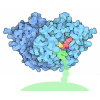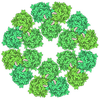+ Open data
Open data
- Basic information
Basic information
| Entry | Database: PDB / ID: 9qb8 | |||||||||||||||
|---|---|---|---|---|---|---|---|---|---|---|---|---|---|---|---|---|
| Title | Lymphostatin - Conformation II - pH 8 Hepes | |||||||||||||||
 Components Components | Lymphostatin | |||||||||||||||
 Keywords Keywords | TOXIN / Virulence Factor Lymphostatin LifA Conformation II | |||||||||||||||
| Function / homology |  Function and homology information Function and homology information | |||||||||||||||
| Biological species |  | |||||||||||||||
| Method | ELECTRON MICROSCOPY / single particle reconstruction / cryo EM / Resolution: 3.4 Å | |||||||||||||||
 Authors Authors | Bottcher, B. / Schneider, R. / Griessmann, M. / Ramussen, T. | |||||||||||||||
| Funding support |  Germany, 4items Germany, 4items
| |||||||||||||||
 Citation Citation |  Journal: Nat Commun / Year: 2025 Journal: Nat Commun / Year: 2025Title: Structure of lymphostatin, a large multi-functional virulence factor of pathogenic Escherichia coli. Authors: Matthias Griessmann / Tim Rasmussen / Vanessa J Flegler / Christian Kraft / Ronja Schneider / Max Hateley / Lukas Spantzel / Mark P Stevens / Michael Börsch / Bettina Böttcher /   Abstract: Lymphostatin is a key virulence factor of enteropathogenic and enterohaemorrhagic Escherichia coli, playing roles in bacterial colonisation of the gut and in the inhibition of lymphocyte ...Lymphostatin is a key virulence factor of enteropathogenic and enterohaemorrhagic Escherichia coli, playing roles in bacterial colonisation of the gut and in the inhibition of lymphocyte proliferation and proinflammatory responses. The protein's glycosyltransferase and cysteine protease motifs are required for activity against lymphocytes, but high-resolution structural information has proven elusive. Here, we describe the structure of lymphostatin from enteropathogenic E. coli O127:H6, determined by electron cryo-microscopy at different pH values. We observe three conformations of a highly complex molecule with two glycosyltransferase domains, one PaToxP-like protease domain, an ADP-ribosyltransferase domain, a vertex domain and a delivery domain. Long linkers hold these domains together and occlude the catalytic sites of the N-terminal glycosyltransferase and protease domains. Lymphostatin binds to bovine T-lymphocytes and HEK-293T cells, forming clusters at the plasma membrane that are internalized. With six distinct domains, lymphostatin can be regarded as a multitool of pathogenic Escherichia coli, enabling complex interactions with host cells. | |||||||||||||||
| History |
|
- Structure visualization
Structure visualization
| Structure viewer | Molecule:  Molmil Molmil Jmol/JSmol Jmol/JSmol |
|---|
- Downloads & links
Downloads & links
- Download
Download
| PDBx/mmCIF format |  9qb8.cif.gz 9qb8.cif.gz | 564.2 KB | Display |  PDBx/mmCIF format PDBx/mmCIF format |
|---|---|---|---|---|
| PDB format |  pdb9qb8.ent.gz pdb9qb8.ent.gz | 450 KB | Display |  PDB format PDB format |
| PDBx/mmJSON format |  9qb8.json.gz 9qb8.json.gz | Tree view |  PDBx/mmJSON format PDBx/mmJSON format | |
| Others |  Other downloads Other downloads |
-Validation report
| Summary document |  9qb8_validation.pdf.gz 9qb8_validation.pdf.gz | 847.5 KB | Display |  wwPDB validaton report wwPDB validaton report |
|---|---|---|---|---|
| Full document |  9qb8_full_validation.pdf.gz 9qb8_full_validation.pdf.gz | 885.5 KB | Display | |
| Data in XML |  9qb8_validation.xml.gz 9qb8_validation.xml.gz | 72.8 KB | Display | |
| Data in CIF |  9qb8_validation.cif.gz 9qb8_validation.cif.gz | 113.7 KB | Display | |
| Arichive directory |  https://data.pdbj.org/pub/pdb/validation_reports/qb/9qb8 https://data.pdbj.org/pub/pdb/validation_reports/qb/9qb8 ftp://data.pdbj.org/pub/pdb/validation_reports/qb/9qb8 ftp://data.pdbj.org/pub/pdb/validation_reports/qb/9qb8 | HTTPS FTP |
-Related structure data
| Related structure data |  52990MC  9euvC  9euwC  9qbbC  9qhhC C: citing same article ( M: map data used to model this data |
|---|---|
| Similar structure data | Similarity search - Function & homology  F&H Search F&H Search |
- Links
Links
- Assembly
Assembly
| Deposited unit | 
|
|---|---|
| 1 |
|
- Components
Components
| #1: Protein | Mass: 366421.219 Da / Num. of mol.: 1 Source method: isolated from a genetically manipulated source Source: (gene. exp.)   |
|---|---|
| #2: Chemical | ChemComp-MN / |
| Has ligand of interest | Y |
| Has protein modification | Y |
-Experimental details
-Experiment
| Experiment | Method: ELECTRON MICROSCOPY |
|---|---|
| EM experiment | Aggregation state: PARTICLE / 3D reconstruction method: single particle reconstruction |
- Sample preparation
Sample preparation
| Component | Name: Lymphostatin / Type: COMPLEX / Entity ID: #1 / Source: RECOMBINANT | |||||||||||||||||||||||||
|---|---|---|---|---|---|---|---|---|---|---|---|---|---|---|---|---|---|---|---|---|---|---|---|---|---|---|
| Molecular weight | Value: 0.366 MDa / Experimental value: NO | |||||||||||||||||||||||||
| Source (natural) | Organism:  | |||||||||||||||||||||||||
| Source (recombinant) | Organism:  | |||||||||||||||||||||||||
| Buffer solution | pH: 8 | |||||||||||||||||||||||||
| Buffer component |
| |||||||||||||||||||||||||
| Specimen | Conc.: 1.25 mg/ml / Embedding applied: NO / Shadowing applied: NO / Staining applied: NO / Vitrification applied: YES | |||||||||||||||||||||||||
| Specimen support | Grid material: COPPER / Grid mesh size: 300 divisions/in. / Grid type: Quantifoil R1.2/1.3 | |||||||||||||||||||||||||
| Vitrification | Instrument: FEI VITROBOT MARK IV / Cryogen name: ETHANE / Humidity: 95 % / Chamber temperature: 4 K |
- Electron microscopy imaging
Electron microscopy imaging
| Experimental equipment |  Model: Titan Krios / Image courtesy: FEI Company |
|---|---|
| Microscopy | Model: TFS KRIOS |
| Electron gun | Electron source:  FIELD EMISSION GUN / Accelerating voltage: 300 kV / Illumination mode: FLOOD BEAM FIELD EMISSION GUN / Accelerating voltage: 300 kV / Illumination mode: FLOOD BEAM |
| Electron lens | Mode: BRIGHT FIELD / Nominal magnification: 130000 X / Nominal defocus max: 1100 nm / Nominal defocus min: 500 nm / Cs: 2.7 mm / C2 aperture diameter: 70 µm / Alignment procedure: ZEMLIN TABLEAU |
| Specimen holder | Cryogen: NITROGEN / Specimen holder model: FEI TITAN KRIOS AUTOGRID HOLDER |
| Image recording | Average exposure time: 9.9 sec. / Electron dose: 70 e/Å2 / Film or detector model: FEI FALCON IV (4k x 4k) / Num. of grids imaged: 3 / Num. of real images: 28915 |
| EM imaging optics | Energyfilter name: TFS Selectris / Energyfilter slit width: 5 eV |
| Image scans | Width: 4096 / Height: 4096 |
- Processing
Processing
| EM software |
| |||||||||||||||||||||||||||||||||||
|---|---|---|---|---|---|---|---|---|---|---|---|---|---|---|---|---|---|---|---|---|---|---|---|---|---|---|---|---|---|---|---|---|---|---|---|---|
| CTF correction | Type: PHASE FLIPPING AND AMPLITUDE CORRECTION | |||||||||||||||||||||||||||||||||||
| Particle selection | Num. of particles selected: 5108934 | |||||||||||||||||||||||||||||||||||
| 3D reconstruction | Resolution: 3.4 Å / Resolution method: FSC 0.143 CUT-OFF / Num. of particles: 298552 / Symmetry type: POINT | |||||||||||||||||||||||||||||||||||
| Atomic model building | Protocol: RIGID BODY FIT | |||||||||||||||||||||||||||||||||||
| Atomic model building | PDB-ID: 9euw Accession code: 9euw / Source name: PDB / Type: experimental model |
 Movie
Movie Controller
Controller




























 PDBj
PDBj



